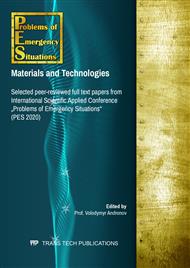p.130
p.136
p.143
p.149
p.158
p.166
p.173
p.179
p.187
Scientific Research Basics of Fire Resistance Testing for Reinforced Concrete Structures and Buildings
Abstract:
Breakthroughs in the development of science and technology of fire testing and fire resistance tests, their present state are discussed, and ideas about the future development of fire resistance tests are given, furthermore the directions in which deeper studies are necessary, are marked. The first revolution in fire resistance testing began not so long ago, in the nineteenth century, when basic tools were developed to measure temperature and heat fluxes. The second revolution in the measurement and understanding of fire occurred in the early twentieth century with the worldwide recognition that scientifically well-reasoned fire-fighting standards are needed to protect people's lives and their property. At the same time, engineering innovations were developed for electromechanical equipment that could automatically record data obtained during a fire experimentally. This progress in data recording has made it possible to study fire behaviour in details. The third revolution in fire resistance testing took place in the second half of the twentieth century with the development of accessible digital data and computer recording equipment that improved data analysis and the development of evidence-based forecast models. The widespread application of technology and computational methods have opened up a theoretical world that provides nuanced insight of fire dynamics and gives the means for development of more effective fire test methods.
Info:
Periodical:
Pages:
158-165
Citation:
Online since:
August 2020
Price:
Сopyright:
© 2020 Trans Tech Publications Ltd. All Rights Reserved
Share:
Citation:


